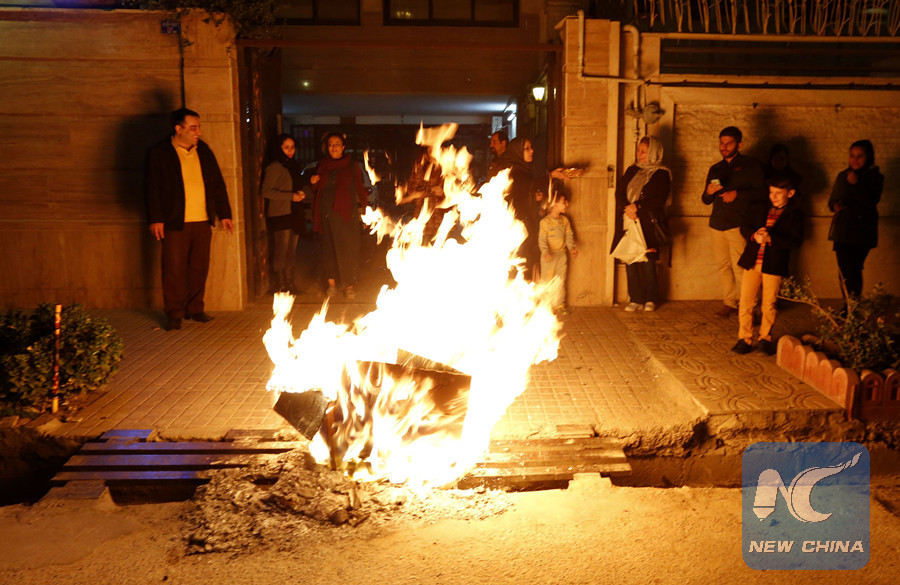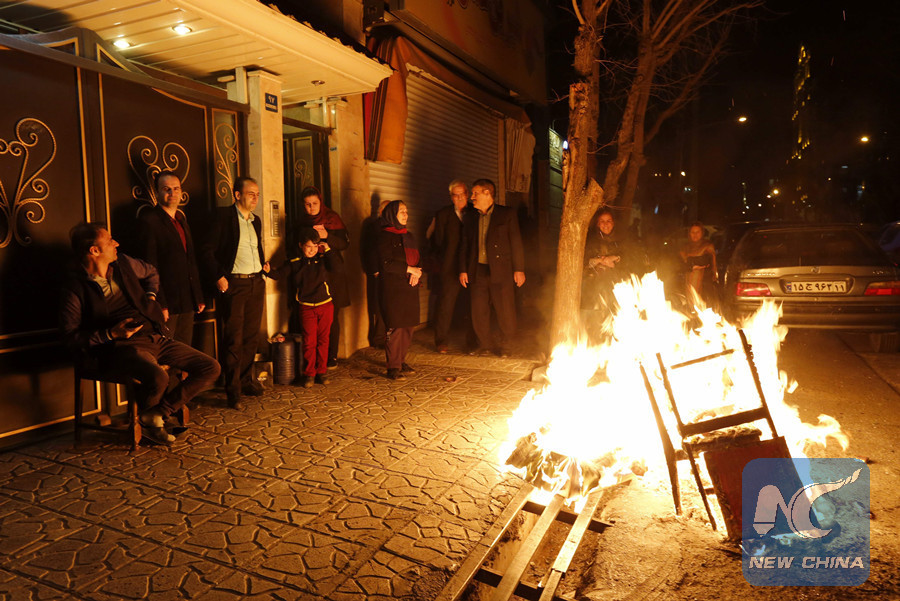
Iranian families light fire outside their houses in Tehran on March 13, 2018 during the Wednesday Fire feast, or Chaharshanbeh Soori, held annually on the last Wednesday eve before the Spring holiday of Nowruz. (AFP photo)
TEHRAN, March 16 (Xinhua) -- Spring cleaning, shopping for special food and clothes, holding fire festival and special street drama is how the Iranians celebrate Nowruz and the start of spring.
New Year festival of Nowruz celebrations, meaning literally the new day, begin on March 21 to greet the coming of a new year for Iranians.
For them, the celebration is rooted in history and means the glorification of growth and vigor in nature.
Preparations for Nowruz begin in early March with spring cleaning locally known as Khaneh Tekani.
Khaneh Tekani, literally shaking the house, is common in almost every household. Carpets and curtains are washed, every corner is dusted, windows are wiped, and old furniture is repaired or replaced with new one.
All family members are involved in this ritual, signifying a fresh start and wash-away of all misfortune.

Iranian families light fire outside their houses in Tehran on March 13, 2018 during the Wednesday Fire feast, or Chaharshanbeh Soori, held annually on the last Wednesday eve before the Spring holiday of Nowruz. (AFP photo)
Also, people head for markets to do shopping for an assortment of goods including new clothes, new shoes, fresh fruits, sweets, nuts, flowers and items necessary to set on the Nowruz Table which is locally known as Sofreh-ye Haft Seen.
Street malls and traditional Bazaars are filled with flowers, plants, colorful clothes and vendors.
Special shopping is made for decorating Sofreh-ye Haft Seen on which a number of symbolic objects are placed during the Nowruz celebrations.
The most common items featuring the Nowruz Table are the Holy Quran, the goldfish, coins, candle sticks, dishes of green sprouts (or Sabzeh), mirrors, decorated eggs, as the signs of good luck, wealth and happiness for the family in the coming year.
Besides, seven other items, the names of which in Persian begin with the sound /s/ are symbolically set on the Sofreh-ye Haft Seen.
People select the seven items from among coin, hyacinths, dried oleaster, sprouts, apple, pudding, garlic, vinegar and sumac, which are given auspicious meaning like wealth, beauty, rebirth, wisdom, health, power and sunrise.
The Iranian also actively participate in Chaharshanbeh Suri, or the fire festival, on the eve of the last Wednesday to bid farewell to the old year and start a prelude to the new year.
With the fall of the dusk on Tuesday, Iranians celebrate the fire festival by jumping over bonfires and using firecrackers in public places, which has its roots in the ancient customs and history of the country.
As people jump over the bonfires, they sang anthems for the fire under their feet, figuratively trading the warmth and beauty of the flames.
The hymns also signify to beat out all the misfortunes and impurities of the past year and get ready for the new resolutions in the coming year.
In the coldest regions of the country and following the fire festival, people gather in their elders' houses eating Chaharshanbe Suri Ajil, or a mixture of raw nuts, raisins, figs and berries.

Iranian families light fire outside their houses in Tehran on March 13, 2018 during the Wednesday Fire feast, or Chaharshanbeh Soori, held annually on the last Wednesday eve before the Spring holiday of Nowruz. (AFP photo)
In the past, young people used to wear disguises and go door to door knocking on doors to receive Chaharshanbe Suri Ajil. The rite is fading away in the modern Iran.
Meanwhile, Haji Firouz, who is a fictional character in the Iranian folklore, appears on the streets to herald the coming of Nowruz.
His face is covered in soot and he is clad in bright red clothes and a felt hat.
Haji Firouz entertains passers-by in the public places by singing traditional songs and dancing and playing his tambourine for a few coins.
As the last day of the year comes to an end, "everyone rushes home to be with their families and loved ones. The New Year is all about celebrating those special moments and sharing the joy and gratitude with family members. While the clock is ticking away and the New Year is approaching, the family sits around the specially prepared Sofreh-ye Haft Seen."
On the first day of New Year, people usually get up early and put on their best clothes to receive visitors or to go visiting the elders.
Nowruz holiday in Iran is a two-week event. A wide range of cultural performances and traditions also take place.
On the days of Nowruz, there is much feasting, visiting family members and friends, and exchanging gifts.
During this period, people pay visits to each other's houses and entertain their guests with fresh fruits and nuts.
It is a tradition for the elders to give money called Eidi to the children. Nowruz holiday is also a perfect opportunity for the families to go on trips making these two weeks a prime travel season.
Families and communities share a symbolic meal, often consisting of cooked rice and vegetables combined with many local ingredients.
In recognition of the importance of this ancient rite, Nowruz was inscribed on UNESCO's Representative List of the Intangible Cultural Heritage of Humanity in 2009. Moreover, in 2010, the United Nations General Assembly proclaimed 21 March International Nowruz Day.

